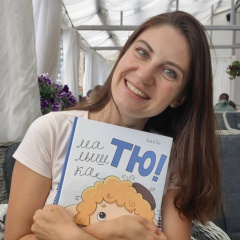Читаю японские сказки, размышляю. Подруга Полина напомнила, что в Японии, как и везде, существуют свои сказки у каждой префектуры. В этом смысле российские сборники, видятся мне в более выйгрышном свете, ведь в них часто указано происхождение сказки (префектура, город и т.п.) и их география оказывается довольно обширной. В то время как в сборниках на японском языке для малышей, которые есть у меня, довольно стандартный набор сказок без указания региона. И только благодаря все той же Полине у меня есть маленький сборник сказок Киото 京都神社の昔ばなし (kyo:to jinja-no mukashibanashi).
У нас дома есть отдельно изданная окинавская сказка "Обезьянье царство" в пересказе Веры Марковой (Речь, 2014). Поучительная история, но вот незадача, не совпадает с японской ???? Точнее с теми, двумя, что мы нашли в интернете. Сначала опишу сюжет русского варианта.
У отца было три сына, старшие ушли на заработки, а младший трижды получал монетки, чтобы купить товар на продажу и трижды тратил их на спасение несчастных животных: кота, собаки и обезьянки. Обезьянка в благодарность отвела мальчика к повелителю обезьян и тот подарил ему волшебную монетку. Сосед позавидовал, взял монетку на время, и вернул подделку. Кот и собака помогли вернуть монетку.
Мы с Полиной нашли в интернете два варианта сказки на японском и оба они сильно короче русской версии. И ни в одном, ни во втором у главного героя нет двоих старших братьев, которые в "Обезьяньем царстве" так сильно напоминают нам сказки про царевну лягушку, про конька-горбунка и прочие "третий вовсе был дурак". Отца тоже нет. В одном варианте главный персонаж взрослый человек, он идёт и спасает тонущую обезьянку, благодарная мама обезьяна дарит ему монетки. А во втором - мальчик живёт с мамой, пытается уйти на заработки, но каждый раз тратит деньги на спасение замученных животных. За спасение обезьянки получает сокровище.
Названия тоже отличаются от "Обезьянье царство", одна называется 猿の三枚銭 (Три монетки обезьяны), другая
ねこと犬とさるのたからもの (Сокровище кошки, собаки и обезьяны).
И вот мы с Полиной не можем понять, то ли надо лучше искать тот вариант с которого переводила Вера Николаевна, то ли она в свой пересказ привнесла кое-что от себя, чтобы сюжет стал ближе нашему читателю Интересно было бы узнать с какими источниками работала Вера Николаевна. Мне представляется огромный толмуд без картинок и жёлтые страницы.
Хотя, конечно, легко может оказаться, что есть много версий сказки. Или они уже в современном мире стали пересказываться на разные лады. Есть, например, старинная сказка про Обезьяну и краба. Обезьяна, обманув краба, выменяла у него рисовый колобок на бесполезную. семечеку хурмы. Но Краб вырастил дерево из семечка, однако не мог забраться на дерево, чтобы полакомиться плодами. Обезьяна за забралась на дерево, стала есть фрукты и зашибла краба насмерть зелёной хурмой. Дети краба плакали над почившим родителем и отомстить за них вызвалась разношёрстная команда. Как пишет Википедия состав команды меняется в зависимости от региона. В моей японской книжке это ступка, пчела, жёлудь и коровья лепешка. В современных изданиях для малышей часто отсутствует подробность о смерти краба, но в моем сборнике для детей 3-6 лет краб действительно умирает.
Кроме того Википедия рассказывает о другом варианте сюжета:
"Обезьяна взбирается на дерево и забирает всю хурму себе, краб советует ей повесить корзину с фруктами на тонкую веточку. Когда обезьяна поступает по совету краба, ветка ломается и хурма из корзины рассыпается по земле. Краб быстро хватает плод и утаскивает его в нору. Рассерженная обезьяна решает испражниться на краба, и пристраивает свой зад к отверстию норы. Краб, тем временем, быстро обривает ягодицы обезьяны. Оттого, будто бы, по сей день обезьяны имеют голый зад, а на клешнях крабов растут волоски."
Ну что ж, поверим, что и у "Обезьяньева царства", даже в пределах одного региона есть много версий.
У нас дома есть отдельно изданная окинавская сказка "Обезьянье царство" в пересказе Веры Марковой (Речь, 2014). Поучительная история, но вот незадача, не совпадает с японской ???? Точнее с теми, двумя, что мы нашли в интернете. Сначала опишу сюжет русского варианта.
У отца было три сына, старшие ушли на заработки, а младший трижды получал монетки, чтобы купить товар на продажу и трижды тратил их на спасение несчастных животных: кота, собаки и обезьянки. Обезьянка в благодарность отвела мальчика к повелителю обезьян и тот подарил ему волшебную монетку. Сосед позавидовал, взял монетку на время, и вернул подделку. Кот и собака помогли вернуть монетку.
Мы с Полиной нашли в интернете два варианта сказки на японском и оба они сильно короче русской версии. И ни в одном, ни во втором у главного героя нет двоих старших братьев, которые в "Обезьяньем царстве" так сильно напоминают нам сказки про царевну лягушку, про конька-горбунка и прочие "третий вовсе был дурак". Отца тоже нет. В одном варианте главный персонаж взрослый человек, он идёт и спасает тонущую обезьянку, благодарная мама обезьяна дарит ему монетки. А во втором - мальчик живёт с мамой, пытается уйти на заработки, но каждый раз тратит деньги на спасение замученных животных. За спасение обезьянки получает сокровище.
Названия тоже отличаются от "Обезьянье царство", одна называется 猿の三枚銭 (Три монетки обезьяны), другая
ねこと犬とさるのたからもの (Сокровище кошки, собаки и обезьяны).
И вот мы с Полиной не можем понять, то ли надо лучше искать тот вариант с которого переводила Вера Николаевна, то ли она в свой пересказ привнесла кое-что от себя, чтобы сюжет стал ближе нашему читателю Интересно было бы узнать с какими источниками работала Вера Николаевна. Мне представляется огромный толмуд без картинок и жёлтые страницы.
Хотя, конечно, легко может оказаться, что есть много версий сказки. Или они уже в современном мире стали пересказываться на разные лады. Есть, например, старинная сказка про Обезьяну и краба. Обезьяна, обманув краба, выменяла у него рисовый колобок на бесполезную. семечеку хурмы. Но Краб вырастил дерево из семечка, однако не мог забраться на дерево, чтобы полакомиться плодами. Обезьяна за забралась на дерево, стала есть фрукты и зашибла краба насмерть зелёной хурмой. Дети краба плакали над почившим родителем и отомстить за них вызвалась разношёрстная команда. Как пишет Википедия состав команды меняется в зависимости от региона. В моей японской книжке это ступка, пчела, жёлудь и коровья лепешка. В современных изданиях для малышей часто отсутствует подробность о смерти краба, но в моем сборнике для детей 3-6 лет краб действительно умирает.
Кроме того Википедия рассказывает о другом варианте сюжета:
"Обезьяна взбирается на дерево и забирает всю хурму себе, краб советует ей повесить корзину с фруктами на тонкую веточку. Когда обезьяна поступает по совету краба, ветка ломается и хурма из корзины рассыпается по земле. Краб быстро хватает плод и утаскивает его в нору. Рассерженная обезьяна решает испражниться на краба, и пристраивает свой зад к отверстию норы. Краб, тем временем, быстро обривает ягодицы обезьяны. Оттого, будто бы, по сей день обезьяны имеют голый зад, а на клешнях крабов растут волоски."
Ну что ж, поверим, что и у "Обезьяньева царства", даже в пределах одного региона есть много версий.
I read Japanese fairy tales, reflect. Friend Polina recalled that in Japan, as elsewhere, each prefecture has its own fairy tales. In this sense, I see Russian collections in a more winning light, because they often indicate the origin of a fairy tale (prefecture, city, etc.) and their geography turns out to be quite extensive. While in the collections in Japanese for kids that I have, there is a fairly standard set of fairy tales without specifying the region. And only thanks to the same Polina, I have a small collection of Kyoto fairy tales 京都 神社 の 昔 ば な し (kyo: to jinja-no mukashibanashi).
At home we have a separately published Okinawan fairy tale "The Monkey Kingdom" retelling by Vera Markova (Rech, 2014). An instructive story, but bad luck, does not coincide with the Japanese ???? More precisely, with the two that we found on the Internet. First, I will describe the plot of the Russian version.
The father had three sons, the elders went to work, and the youngest received coins three times to buy goods for sale and spent three times to save the unfortunate animals: a cat, a dog and a monkey. The monkey, in gratitude, took the boy to the monkey lord, and he presented him with a magic coin. The neighbor was jealous, took the coin for a while, and returned the fake. The cat and the dog helped return the coin.
Polina and I found on the Internet two versions of the fairy tale in Japanese, and both of them are much shorter than the Russian version. And neither in one nor in the second does the main character have two older brothers, who in "The Monkey Kingdom" so strongly remind us of the fairy tales about the frog princess, about the humpbacked horse and others "the third was a fool at all." There is no father either. In one version, the main character is an adult, he goes and rescues a drowning monkey, a grateful mother monkey gives him coins. And in the second, the boy lives with his mother, tries to go to work, but every time he spends money to save the tortured animals. For saving the monkey, he receives a treasure.
The names are also different from "Monkey Kingdom", one is called 猿 の 三枚 銭 (Three Monkey Coins), the other
ね こ と 犬 と さ る の た か ら も の (Cat, dog and monkey treasure).
And so Polina and I cannot understand whether it is better to look for the version from which Vera Nikolaevna translated, or whether she brought something of herself into her retelling so that the plot would become closer to our reader It would be interesting to find out what sources Vera worked with Nikolaevna. It seems to me a huge tolmud without pictures and yellow pages.
Although, of course, it can easily turn out that there are many versions of the tale. Or they have already begun to be retold in different ways in the modern world. There is, for example, an old tale about the Monkey and the crab. The monkey, having deceived the crab, exchanged a rice ball from him for a useless one. persimmon seed. But the Crab grew a tree from a seed, but he could not climb the tree to feast on the fruits. The monkey climbed a tree, began to eat fruit and hit the crab to death with a green persimmon. The children of the crab cried over the deceased parent and a motley team volunteered to avenge them. According to Wikipedia, the composition of the team varies depending on the region. In my Japanese book, it's a mortar, a bee, an acorn, and a cow cake. In modern publications for toddlers, details about the death of a crab are often missing, but in my collection for children 3-6 years old, the crab does die.
In addition, Wikipedia talks about another version of the plot:
"The monkey climbs a tree and takes all the persimmons for himself, the crab advises him to hang the basket of fruit on a thin twig. When the monkey follows the crab's advice, the branch breaks and the persimmon from the basket scatters on the ground. The crab quickly grabs the fruit and drags it into the hole. the monkey decides to defecate on the crab, and attaches his butt to the hole of the hole. The crab, meanwhile, quickly shaves the buttocks of the monkey. Because, as if, to this day, monkeys have a bare bottom, and hairs grow on the claws of crabs. "
Well, let's believe that the "Monkey Kingdom" has many versions even within the same region.
At home we have a separately published Okinawan fairy tale "The Monkey Kingdom" retelling by Vera Markova (Rech, 2014). An instructive story, but bad luck, does not coincide with the Japanese ???? More precisely, with the two that we found on the Internet. First, I will describe the plot of the Russian version.
The father had three sons, the elders went to work, and the youngest received coins three times to buy goods for sale and spent three times to save the unfortunate animals: a cat, a dog and a monkey. The monkey, in gratitude, took the boy to the monkey lord, and he presented him with a magic coin. The neighbor was jealous, took the coin for a while, and returned the fake. The cat and the dog helped return the coin.
Polina and I found on the Internet two versions of the fairy tale in Japanese, and both of them are much shorter than the Russian version. And neither in one nor in the second does the main character have two older brothers, who in "The Monkey Kingdom" so strongly remind us of the fairy tales about the frog princess, about the humpbacked horse and others "the third was a fool at all." There is no father either. In one version, the main character is an adult, he goes and rescues a drowning monkey, a grateful mother monkey gives him coins. And in the second, the boy lives with his mother, tries to go to work, but every time he spends money to save the tortured animals. For saving the monkey, he receives a treasure.
The names are also different from "Monkey Kingdom", one is called 猿 の 三枚 銭 (Three Monkey Coins), the other
ね こ と 犬 と さ る の た か ら も の (Cat, dog and monkey treasure).
And so Polina and I cannot understand whether it is better to look for the version from which Vera Nikolaevna translated, or whether she brought something of herself into her retelling so that the plot would become closer to our reader It would be interesting to find out what sources Vera worked with Nikolaevna. It seems to me a huge tolmud without pictures and yellow pages.
Although, of course, it can easily turn out that there are many versions of the tale. Or they have already begun to be retold in different ways in the modern world. There is, for example, an old tale about the Monkey and the crab. The monkey, having deceived the crab, exchanged a rice ball from him for a useless one. persimmon seed. But the Crab grew a tree from a seed, but he could not climb the tree to feast on the fruits. The monkey climbed a tree, began to eat fruit and hit the crab to death with a green persimmon. The children of the crab cried over the deceased parent and a motley team volunteered to avenge them. According to Wikipedia, the composition of the team varies depending on the region. In my Japanese book, it's a mortar, a bee, an acorn, and a cow cake. In modern publications for toddlers, details about the death of a crab are often missing, but in my collection for children 3-6 years old, the crab does die.
In addition, Wikipedia talks about another version of the plot:
"The monkey climbs a tree and takes all the persimmons for himself, the crab advises him to hang the basket of fruit on a thin twig. When the monkey follows the crab's advice, the branch breaks and the persimmon from the basket scatters on the ground. The crab quickly grabs the fruit and drags it into the hole. the monkey decides to defecate on the crab, and attaches his butt to the hole of the hole. The crab, meanwhile, quickly shaves the buttocks of the monkey. Because, as if, to this day, monkeys have a bare bottom, and hairs grow on the claws of crabs. "
Well, let's believe that the "Monkey Kingdom" has many versions even within the same region.




У записи 17 лайков,
0 репостов,
363 просмотров.
0 репостов,
363 просмотров.
Эту запись оставил(а) на своей стене Ира Батуева





































